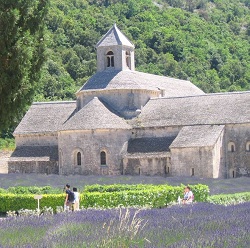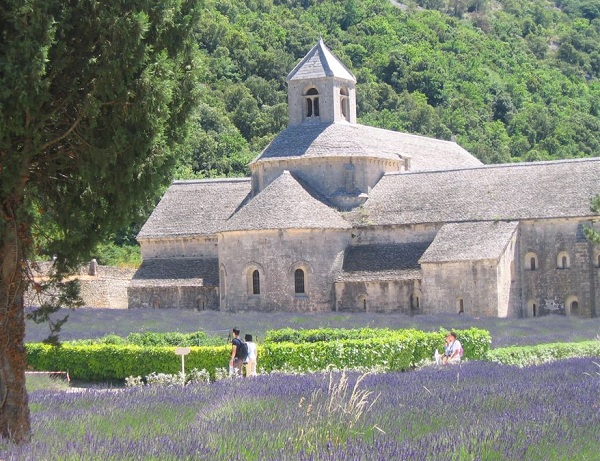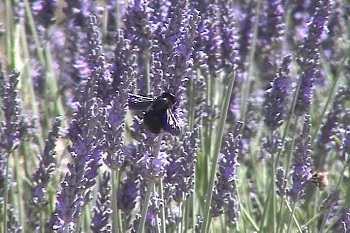
In Provence, contributor Elizabeth Esris breaks through the picture-post card view of lavender and old stones and allows her imagination to take over while visiting the Abbey of Sénanque in the region’s Vaucluse area.
* * *
By Elizabeth Esris
If you buy a calendar for a Francophile around the holidays, the kind in which each month is a spectacular scene from a different region in France, chances are that July or August will feature a view of long, arching rows of lavender running to a gray stone abbey that evokes romantic visions of Provence.
I drove into that very scene on a summer day as I approached the Abbey of Sénanque. The view of the mass of vibrant lavender against the stark eloquence of the 12th century Romanesque monastery took my breath way.
I wasn’t alone. The spectacular scene is shared by many visitors drawn to this rural valley just north of the chic and stunning perched village of Gordes. Walking the dusty path from the parking lot amid the quiet conversation of others, I knew that I needed to move beyond the photo op in order to make my visit a lasting and intimate experience. When I approached the old stone walls, I wanted to engage my imagination as I learned about their history.

The Abbaye Notre-Dame de Sénanque was established when local lords donated land to build a Cistercian monastery in 1148, 50 years after the founding of the mother of Cistercian abbeys at Citeaux in Burgundy. At Sénanque, twelve monks were brought to live in huts while construction of the abbey was begun.
The church of the monastery was consecrated in 1178, though it wasn’t until 1250 that other essential buildings such as residences and the refectory (dining hall) were complete. Over time additional structures of a self-sustaining medieval religious community were added, including a cloister, a chapter house for meetings, a scriptorium for writing of manuscripts, and barns and other outbuildings that were part of a series of granges for food production. Four mills completed a productive agricultural community that enabled the diligent and entrepreneurial Cistercians to lord over a prosperous center of influence in Provence well into the 15th century.
In addition to being an industrious order that worked hard to create efficient agricultural techniques, the Cistercians also established a core group of lay members at the Abbey of Sénanque who toiled at the most arduous manual tasks in the granges and at the mills. These men lived within the monastery, but slept and ate in separate quarters.
Perhaps it was inevitable that with prosperity came exploitation of the Cistercian’s original religious mission. The riches of the agricultural operations afforded temptations that gave way to worldly pleasures and diversion from the precepts of simplicity and service. Profiteers within the order eventually took control of the monastery in the 1400s, and it fell into decline because of mismanagement and corruption.
The Cistercian mission for a life of austerity and manual labor was reinforced once more at Sénanque in 1475 when a new abbot, John Casaletti from Avignon, was appointed to oversee the monastery and return focus to the values of the Cistercians. The abbey prospered again and became an agent for ministering to the poor, including caring for victims of the plague early in the 16th century.
In 1544 the abbey became a victim of the Wars of Religion when it was attacked by the Vaudois whose oppression and slaughter in the region had been sanctioned by the Catholic Church since the 12th century. The Vaudois pillaged the abbey and destroyed the lay quarters. The Abbey of Sénanque never recovered its prosperity and influence, and during the French Revolution the property was nationalized.
In ensuing years the monastery changed hands a number of times until monastic life was again established in 1988 by the small Cistercian order that lives there today. The community is for the most part financially self-sufficient through income from tours of the monastery, production of lavender and honey, sales of related items in the gift shop, and hosting of overnight visitors, though on occasion the French state and the department of Vaucluse have provided financial assistance to keep this historic setting alive and in good condition.
Learning some of the history of the Abbey of Sénanque in guidebooks, in pamphlets, and during a tour led me to ruminate about monastic and rural life in medieval Provence. I imagined the narrow mountain road (now D177), which leads to the valley from Gordes, as a dusty mountain path upon which novices came by foot, or perhaps on saddle, to begin a life of silence, simplicity, and long hours of labor in the fields. I asked myself who they were and what drew them to such an austere life. I envisioned them nearing the rugged stone walls that would become their refuge—perhaps their prison—and I tried to sense their last images of home and the anticipation of what awaited them.
The Abbey of Sénanque was built without a main door to the primary façade; this emphasized the aestheticism of the Cistercians and their desire that the monastery be unadorned. It also reinforced the insular quality of the community and its purpose in sustaining a simple and silent life away from distractions that a grand portal might communicate to those outside the order.

It was in late June, amid the brilliance of the early blossoming of lavender, when I stepped inside the monastery.
When the voice of the tour guide echoed through the severe but beautiful vaulted dormitory where at night the monks once slept fully clothed in marked sections on the hard floor, I asked myself if they slept peacefully, fatigued by the day’s labor or if they were stalked by dreams of life outside their cloister.
In the scriptorium, the chamber where monks in medieval times worked copying manuscripts, I imagined faces bearing down on parchment and the meticulous lines of letters that inched slowly across the page, formed by hands that ached by day’s end and eyes that wearied with the dimming of natural light. It is the only room with a fireplace—heated so that the monks could perform their delicate work.
The abbey church was and is still a place of prayer and contemplation. (It’s possible for visitors to attend mass here.) Even though it is stark, the symmetry of the nave speaks of artistry—restrained artistry, an aesthetic that denies excess but is unable to deny beauty. The aim might have been austerity, but when the eye follows the arches to the line in the vaulted ceiling, the radiance of sunlight on stone feels like adornment.
The most memorable part of the abbey is outside, where the eye collides with an impossibly beautiful vision: thousands of lavender flowers, growing in even rows, sway with abandon in the valley breeze against the gray walls of the monastery. It’s at once simple and sublime. Large slate tiles top roof lines. Low sections of the abbey emphasize the rustic nature of the setting, while the rounded lines of the apse and the angles leading to the bell tower suggest the divine. How many stories played out in the heat of the Provençal sun and behind the secretive windows of the monastery? The eye returns to the lavender and back again to the monastery.
 On a warm summer day, arriving very early or late in the afternoon, one can avoid seeing buses and hordes of tourists with cameras taking the inevitable shots of lavender against the gray stone. It is possible then, to indulge in fantasy of how it was in medieval times—or how it is today among the robed inhabitants. I visited twice, both times in late June before the height of the tourist season but just in time for the lavender. Both times I stooped low to watch large black bees hover over blossoms , and I looked through the lavender to the abbey wondering how villagers viewed this monastery and it inhabitants so long ago. I imagined an alter ego sitting atop the roof in summer, ruminating about the insular monks who lived within.
On a warm summer day, arriving very early or late in the afternoon, one can avoid seeing buses and hordes of tourists with cameras taking the inevitable shots of lavender against the gray stone. It is possible then, to indulge in fantasy of how it was in medieval times—or how it is today among the robed inhabitants. I visited twice, both times in late June before the height of the tourist season but just in time for the lavender. Both times I stooped low to watch large black bees hover over blossoms , and I looked through the lavender to the abbey wondering how villagers viewed this monastery and it inhabitants so long ago. I imagined an alter ego sitting atop the roof in summer, ruminating about the insular monks who lived within.
Those reflections evolved into the poem, “Musing at the Abbey.”
Musing at the Abbey
In a tide of lavender
arms dappled by sun and stem
vie with black bees for nectar.
The stone wall of the abbey
is weary of the artist’s brush and
bleach of lenses.
It breathes them away
with memory of silent skies and
novices on dusty roads.
Women appear on the tiled roof
with gauze skirts draped
between their thighs.
They bathe in the June sun,
listen to the steps of monks
inching toward prayer,
and whisper to them
with attar from the blooms.
I join them in their hopeless vigil,
my arms hungry
for the heat of summer prayer.
They know me from a dozen other churches.
We have stalked robed ghosts before,
seducing ourselves with chants
of hooded profiles
who share lavender
with black bees
in a quiet coupling
of earth and the divine.
© Elizabeth Esris
Poem first published as “At the Abbey” in Women Writers, June, 2009.
Accompanying text first published in France Revisited, Dec. 2011
Also read Elizabeth’s explorations of and poem about the massacre of the Vadois at Mérindol in the Luberon area of Provence.


Thank you again for your research and insight. I visited Senanque in May 2011. The was warm, but too early for Lavender. A walk up from Gordes on a snowy January should take one back to THE NAME OF THE ROSE. Also, sleeping on the floor during the winter is difficult to contemplate.
And thank you for the kind read. I love the Name of the Rose reference. Your mention of it made me feel the interior of the abbey as if I were there.
How beautiful and breath taking. I am a big lavendar avocate and I must say that in looking at the pictures, reading the story and closing my eyes, I took my self to this beautiful field of lavendar & i can smell the essacne of the lavendar blowing through the fields . France seems to be a BEAUTIFUL place. I am going add this to my bucket list in hopes to make it there before my time here on earth ends. Thank you soo much for sharing this beauty…….
Kind words–I hope you get to experience the beauty in person!
Thank you so much for this article. I’m writing a novel set in Provence and this was so inspirational. Cheers.